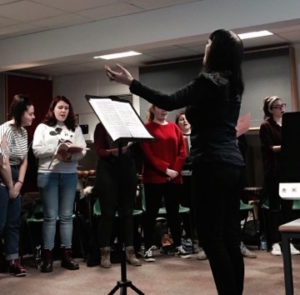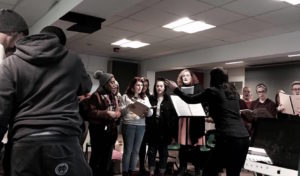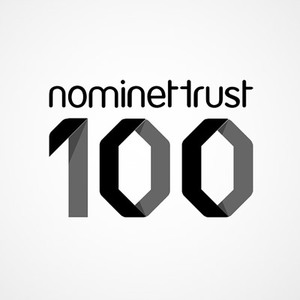Presentation at: Teaching and supporting a digital future: UoN Showcase 4th February 2022
Wray Irwin talks about Changemaker Support (highlighting how the team supports staff and students’ digital employability)
The recording of the event is available to view
Presentation at: Teaching and supporting a digital future: UoN Showcase 4th February 2022
Emma Whewell and Helen Caldwell (Associate Professors) share their recent paper on: Changemakers as digital makers: Connecting and co-creating. Written in collaboration with Mark Frydenberg from Bentley University, Boston USA and Professor Diana Andone, University of Timisoara, Romania, published in Education and Information Technologies (January 2022)
This paper presents data from two international projects focused on the interaction between changemaking and digital making in university students. The data is drawn from the contributions of 63 university students located in the United States, Romania, Spain, Belgium, Norway, Denmark and England. Using a design thinking methodology and a thematic analysis of student responses, the aim was to understand how the creative use of immersive technologies, such as augmented and virtual reality, might create an environment for changemaking practices in an international context. Findings suggest that students demonstrated not only enhanced digital skills and student engagement but increased cultural competence and global mindfulness. International digital collaboration can create conditions for students to develop changemaker attributes and identify as changemakers within the spheres of entrepreneurship and education, preparing them to be a force for change in the world.
The article is available here: https://link.springer.com/article/10.1007/s10639-022-10892-1
The recording of the event is available to view
By Dr. Jasmine Shadrack, Senior Lecturer in Popular Music, FAST
 As this year’s choir have been asked to perform at the opening ceremony of Waterside, as well as our own performance at the Royal next June, it was important to choose a piece of music that had the wow factor. And for me, that has to be Mozart’s Requiem Mass in D Minor. It was the first piece I ever conducted so I have very fond memories of it. I have also performed it myself as a soprano during my undergraduate degree so my knowledge of it is intimate. The fact that Mozart knew he was dying when he wrote it, makes the piece all the more poignant and special.
As this year’s choir have been asked to perform at the opening ceremony of Waterside, as well as our own performance at the Royal next June, it was important to choose a piece of music that had the wow factor. And for me, that has to be Mozart’s Requiem Mass in D Minor. It was the first piece I ever conducted so I have very fond memories of it. I have also performed it myself as a soprano during my undergraduate degree so my knowledge of it is intimate. The fact that Mozart knew he was dying when he wrote it, makes the piece all the more poignant and special.
The music for it will take a longer time to come together but the choir are making great strides already. We have completed (in the most part!) the Aeternam and the Kyrie Eleison (the first two movements) as well as learning some traditional Christmas carols too (for a lunch time concert later in the term). This time I am joined by a new member of staff, Miss Francesca Stevens who does a two hour vocal training session a week to support what I do every Monday in choir rehearsal. Already I have noticed the bond starting to form, not just between each section of the choir, but as a unit too. One of the things I love most about doing this is watching everyone work together for a common goal. It is active blended learning at every stage, from the rehearsals all the way through to the performance. Not only do they learn close score reading, sight reading , close part harmony, how counterpoint functions, effective breathing techniques, good pronunciation, professional conduct and critical listening, they also forge real solidarity as a cohort that spans across all years of the popular music undergraduate degree.
They are able to exercise their own autonomy by using their voice. This might sound simplistic but it really helps to acknowledge that one voice can have a huge impact on a choir. Through their subjective involvement, they take part and contribute to an objective goal so it is experiential. They also gain empowerment through their learning community. As the choir is voluntary, it means that they are there because they want to be and they are not doing it for assessment purposes. I have tried making it assessable previously and it just didn’t work; it actually undermined all the camaraderie and fun we have with it. There is a real sense of inclusivity too that reflects on their personal responsibility to the choir.
So, at week three of the choir in term 1, we are making great progress and having fun at the same time!
Jasmine will be keeping us up to date with the progress of the choir, but this post is also one in a series of ABL Practitioner Stories, published in the countdown to Waterside. If you’d like us to feature your work, get in touch: LD@northampton.ac.uk
In 2013 the Nominet Trust launched the Social Tech Guide. The aim of the guide is to promote and celebrate inspiring uses of technology for social good. Each year they publish the Nominet Trust 100, a guide to the 100 best digital technologies for social innovation. The 2015 guide has just been published and features a wide variety of technologies, from Flowy, a game to help people combat panic attacks, to MOM, an inflatable incubator for use with premature babies in the developing world, to WREX, a robotic exoskeleton to help children with neuromuscular diseases.
You can find out more and view the guide here: http://socialtech.org.uk/
 As Learning Designers, my colleagues Rob, Julie and myself are always looking for ways to help staff with the transition to Waterside and in (re-)designing their modules and programmes to take account of new ways of learning and teaching. To this end, there are a number of posts here on the flipped classroom, or on de-mystifying the CAIeRO for example, that aim to take away some of the apprehensions that we know exist.
As Learning Designers, my colleagues Rob, Julie and myself are always looking for ways to help staff with the transition to Waterside and in (re-)designing their modules and programmes to take account of new ways of learning and teaching. To this end, there are a number of posts here on the flipped classroom, or on de-mystifying the CAIeRO for example, that aim to take away some of the apprehensions that we know exist.
What does teaching mean to you?
Another recent initiative has been a series of activities designed to help staff begin the process of reconceptualising how they teach and articulating their individual teaching style. In the midst of discussions around whether or not we are going to be a fully-online University (definitely ‘not’), or what the ‘new model’ for learning and teaching is going to be (the decision is for you and your team to determine- within certain parameters), it is easy to lose sight of the value of what staff do each and every day in the classroom – our face-to-face contact time (for an understanding of what we mean by ‘contact time’, including face-to-face and online, click here – sign in required). Through conversations with ILT generally and Shirley Bennett, our Head of Academic Practice, we hope to help our staff identify what it is that they value about their face-to-face contact time, and then use technology to help them do more of what they value in the classroom. In starting from this perspective, the aim is to conceptualise technology as an enabler, of excellence in learning and teaching rather than a driver.
In response to the question What do you value about your face-to-face teaching? staff have produced some interesting and sometimes unexpected visual metaphors that will be the subject of a later blog. The workshop/Away Day was also used to set a challenge around learning and teaching innovations through reflectiong on past innovations (to you) and sharing ideas with colleagues.
A 21st Century Learning and Teaching SWOT Analysis
 Our Institute for Learning and Teaching have recently produced a short video that many staff may have already seen, showing the general direction of travel for the 2015-2020 learning and teaching plan. It is important to stress that this model is only one approach – if you have an alternative that is more appropriate to your teaching style and your discipline, then there is no reason for you not to explore how that might look in practice.
Our Institute for Learning and Teaching have recently produced a short video that many staff may have already seen, showing the general direction of travel for the 2015-2020 learning and teaching plan. It is important to stress that this model is only one approach – if you have an alternative that is more appropriate to your teaching style and your discipline, then there is no reason for you not to explore how that might look in practice.
The key part of this arrow is the second stage – learning activities that help students to make sense of the content. These can be either online or face-to-face depending on tutors’ individual pedagogy and subject discipline. What works for one subject, might be wholly unsuitable for another – and this is why we are keen to help staff articulate their pedagogical preferences and continue the process of enhancing their own practice and, as a result, the student experience, rather than simply focussing on the latest piece of technology. As a way in to exploring some of these issues, we facilitated a ’21st Century Learning and Teaching SWOT Analysis’. By 21st century learning and teaching, we mean looking at how we prepare our students for employment in the 21st century, where technology is ubiquitous and constantly evolving, and how we use technology ourselves to enhance our learning and teaching. Identifying individual strengths and weaknesses concerning technology-enhanced learning, and highlighting some of the opportunities and threats these new ways of learning and teaching bring helped staff to begin the process of development and provides indicators of individual training needs.
Determining your blend
We also began the process of looking at how to determine what must be taught face-to-face (content or skills) and what could be taught online. Really, this is about thinking what you want your ‘blend’ to look like and builds on the earlier notions of using technology to enable you to do more of what you value in the classroom. Expressing this in terms of what and how students are learning and not solely in terms of what the tutor is teaching can be tricky but we have activities that can help with this. We can also help you to begin to see how this might look in NILE.
Many course teams and individuals have been engaging in various forms of blended learning within their practice for a long time. Determining how you might need to develop your own practices is not something that you need to do in isolation – as Learning Designers, we are here to help and there is also your School Learning Technologist you can draw on, as well as your colleagues.
Packing your Suitcase for Waterside
 The day concluded with asking to staff to select what they would need to pack in their suitcases in order to get them from where they are today to where they have identified that they would like to be. This tongue-in-cheek exercise involved selecting from a collection of icons and images of things that you might take on holiday and can include, but is not limited to the following: a bucket and spade (to help you build something new); your Kindle to read while sun-bathing on the beach (mobile content creation and delivery); paracetamol (to help get rid of your headache); lifeguard and buoyancy aid (peer support, learn tech training etc); towel to reserve your (deck)chair (desk) and so on.
The day concluded with asking to staff to select what they would need to pack in their suitcases in order to get them from where they are today to where they have identified that they would like to be. This tongue-in-cheek exercise involved selecting from a collection of icons and images of things that you might take on holiday and can include, but is not limited to the following: a bucket and spade (to help you build something new); your Kindle to read while sun-bathing on the beach (mobile content creation and delivery); paracetamol (to help get rid of your headache); lifeguard and buoyancy aid (peer support, learn tech training etc); towel to reserve your (deck)chair (desk) and so on.
On a more serious note, the underlying premise is to identify your training needs, and other ways in which staff can take steps to ‘get ready for Waterside’ and look at what you might do to respond to the challenges of 21st century learning and teaching or the implementation of Changemaker in the Curriculum.
If you or your subject team would like us to facilitate any or all of these activities at an upcoming Staff Development session or Away Day, or to help you design your teaching to enable you to do more of what you value, please email LD@northampton.ac.uk. You know where we are!
Background to the Exchange
Aside from the opportunity to network, my aims in attending the exchange was to examine two main areas – how technology can support the process of innovation and the potential for incorporating System Thinking and Design Thinking into the design of material and even courses. This document summarises my experience and the four lessons I have learned.
Technology and Innovation
Two items on the agenda were particularly relevant here. The MICA Social Design Lab ran during one afternoon – this was a social space designed to encourage interaction between delegates and facilitate discussions, given the question ‘How might we advance social innovation in Higher Education?’
Given the rather spartan conference room environment, the range of fun, brightly coloured physical items to record, connect and visualise responses was attractive and facilitators easy to identify. But while idea capture was strong, collection and dissemination was somewhat weaker. Personally, I never encountered any analysis or results from it, though it may have just passed me by. The physical location hampered the exercise too – delegates could too easily pass by and without their physical presence the exercise was reduced in value. Could technology have supported this process better? Yes, I am convinced it could. At the very least, video or photographic capture needs to be on hand to ensure that contributions can still provoke ideas and actions after the event, along with a clear mechanisim to access it. Ultimately, technologies to engage participants, then capture and disseminate material are essential features of an environment that truly wishes to engage stakeholders. How often has a pile of flip chart paper – containing several person hours of contributions at enormous cost – lingered in the corner of my office?
Lesson #1: Low tech is fun and has its place, but technology to engage in, capture and share group deliberation is essential if the exercise is to make a real difference in a design process.
I attended a session entitled ‘Are we succeeding and how would we know?’, where three case studies were discussing in respect of their attempts to measure success. Drew Bewick of the University of Maryland discussed the use of a ‘Return on Engagement’ grid – very much along the lines of a rubric – to measure the operational value, strategic value and risks of projects on a scale of one to five, and recording the resources used, activities, outputs and impact at the same time.
Lizzie Pollock, from Brown University, discussed the measurement of the learning outcomes for individuals being assessed as part of their Social Innovation Fellowship. The items for inclusion included empathy, creative thinking, critical thinking and entrepreneurial ‘grit’. She was still struggling with ways to evidence and measure these attributes – the Torrance Test, for example, was tried, but rejected on the grounds that it was too broad. Brown are also now beginning to consider – like Maryland – impact, including enterprise survival rates and generated revenue.
John Isham, of Middle bury College, had done some interesting work on the three impact areas of the project itself, the student(s) concerned and the Campus, emphasising the inter-relation of all three. He identified a weakness in project management skills amongst participants in projects and was conscious that just ‘building stuff’ is an inadequate measure of success. Students were beginning to be involved with evaluating other students’ projects but this was at a fairly early stage.
Two points struck me here in particular – the lack of pre-determined project management structures or tools can be a barrier both for students who have little or no experience of managing a project and supervisors who have no ‘dashboard’ view of the progress of a project or its outcomes. Secondly, we seem locked into a ‘new year, fresh start’ approach to developing social innovation projects and ignore the lessons of the previous year.
Lesson #2: A project management system – simple and free to use – is needed to support students and their mentors/supervisors/assessors.
Lesson #3: Evaluation of previous social innovation ventures by students before they start their own, would be a valuable learning experience for them and provide data for the hosting institution.
Systems and Design Thinking
Unfortunately, both sessions related to these topics – ‘Systems Thinking for Leading Changemakers’ and ‘Can Everyone be a Designer? ‘Provocations in the Pedagogy of Design Thinking’ failed to fully deliver to my expectations, the latter being a discussion about a process I didn’t understand! Mary Anne Gobble’s summary article (Gobble 2014) has assisted me to a great extent on the topic of Design Thinking. Whether you believe this to be fad or fact, the importance of taking the “beneficiary’s” perspective into account during the design phase of any social innovation would seem to be a critical success factor.
Lesson #4: Empathy is not just a desirable personal attribute; it is a critical success factor in the design process.
Systems Thinking seems to sit uncomfortably in social innovation design, being apparently more suited to translating the messiness of real life into computer software. However, there are clear connections here to the knotty problem of measuring success – by establishing the ‘units’ that exist within a process flow and their rates of change (along with auxiliary variables) we can begin to pinpoint objective measure of success. Overall, I couldn’t see how a non-specialist could apply these techniques easily, though David Castro did provide some interesting resources and links (including free modeling tools such as InsightMaker) that I may well do some more exploration with.
Summary
Clearly there was a lot more that I got out of the visit, some of which are on http://ashokaun15.weebly.com/. I have an excellent contact in Waterloo, Canada who is sharing her experience of embedding Flipboard into teaching with me, along with the Tophat student response system and met a wide range of contacts from around the world. Many of the delegates leave you speechless at the problems they are seeking to overcome and the relentless enthusiasm they still have to press on. Wrangling with a few NILE issues pales into insignificance when trying to develop a system to support 100,000 students in Indian rural schools with no Internet connection!
But as Wray Irwin pointed out before I left, you would be surprised just how far ahead we are in the field of social innovation compared with most. Developing the support infrastructure for prospective social innovators and evaluating our successes and failures more effectively will push us ahead further still.
References
Gobble, MM. (2014). ‘Design Thinking’, Research Technology Management, 57(3), pp. 59-61
Acknowledgements
Many thanks to Tim Curtis for inviting me to attend, Rob Howe and Chris Powis for allowing me to go and the ‘awesome’ support of my fellow delegates in Washington.
(a copy of the fully hyper-text linked version of this document can be found at http://1drv.ms/1FEGoad)
“Changemaking is simply where someone spots a social problem and does something about it.”
The Changemaker Certificate has been created and implemented by Fr Tim Curtis in the School of Health as a way of encouraging all staff and students across the University to explore what it means to be a Changemaker and also to award engagement with Changemaking through the completion of a Social Venture Canvas (SVC) that would be capable of attracting financial support.
The Certificate sits in two places at present: (1) tied to academic modules offered from the School of Health – SWK1051 and SWK3025; and (2) as an extra-curricular award not tied to academic credit. The route taken will depend on whether or not the academic modules are offered as part of individual programmes, with the idea being that anyone across the University can therefore participate.
Through a series of coursework activities that all feed in to and contribute towards attainment of each section, participants prepare a draft proposal for an SVC that will be both self- and peer-assessed. Work is assessed using a newly-designed ‘CM Assessment Rubric‘ that draws on and modifies a number of identified 21st Century Skills. Achievement comes either through attaining the Certificate in isolation at either bronze, silver or gold level; or, for students on SWK1051, the rubric provides clear links to either the gold, silver or bronze certificates, but uses submission deadlines and the standard UMF scores to determine achievement levels. While it may depend on the social venture being addressed and the work carried out by the student, students completing SWK1051 are most likely to attain the bronze certificate (which is around concepts of thinking and exploring a social venture idea), with some credit at silver. The final venture canvas would still require to be submitted to the Changemaker Certificate system however.
- For more on the Changemaker Certificate case study, please see Changemaker assessment final.
- To enrol on the Changemaker Certificate for yourself, please click here.
Recent Posts
- Spotlight on Excellence: Bringing AI Conversations into Management Learning
- Blackboard Upgrade – December 2025
- Preparing for your Physiotherapy Apprenticeship Programme (PREP-PAP) by Fiona Barrett and Anna Smith
- Blackboard Upgrade – November 2025
- Fix Your Content Day 2025
- Blackboard Upgrade – October 2025
- Blackboard Upgrade – September 2025
- The potential student benefits of staying engaged with learning and teaching material
- LearnTech Symposium 2025
- Blackboard Upgrade – August 2025
Tags
ABL Practitioner Stories Academic Skills Accessibility Active Blended Learning (ABL) ADE AI Artificial Intelligence Assessment Design Assessment Tools Blackboard Blackboard Learn Blackboard Upgrade Blended Learning Blogs CAIeRO Collaborate Collaboration Distance Learning Feedback FHES Flipped Learning iNorthampton iPad Kaltura Learner Experience MALT Mobile Newsletter NILE NILE Ultra Outside the box Panopto Presentations Quality Reflection SHED Submitting and Grading Electronically (SaGE) Turnitin Ultra Ultra Upgrade Update Updates Video Waterside XerteArchives
Site Admin





